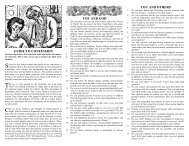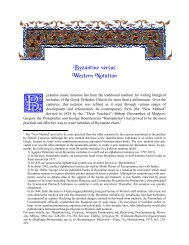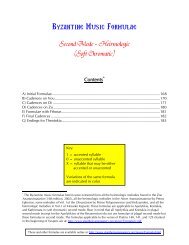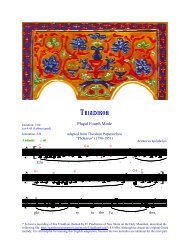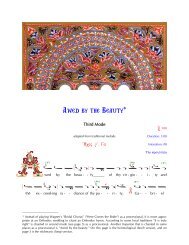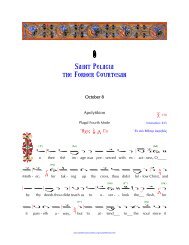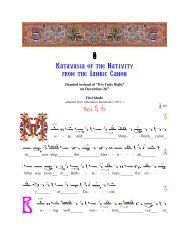Reading Psalmodia (PDF) - St. Anthony's Monastery
Reading Psalmodia (PDF) - St. Anthony's Monastery
Reading Psalmodia (PDF) - St. Anthony's Monastery
Create successful ePaper yourself
Turn your PDF publications into a flip-book with our unique Google optimized e-Paper software.
scales even if we accept Pa rather than Di as having a constant pitch across scales. Theproblem arises from the nature of the soft chromatic scale and the specific notes it uses,rather than from the choice of Pa or Di as a constant pitch across modes.DIAGRAM BI |----------|--------|------------|------------|----------|--------|PA VU GA DI KE ZO NIII (S.C) |--------------|--------|------------|--------|--------------|--------|PA VU GA DI KE ZO NIIII (ENH)|------------|------|------------|------------|------|------------|PA VU GA DI KE ZO NIVI (H.C.)|------|--------------------|----|------------|------|--------------------|PA VU GA DI KE ZO NIVII (DIA)|----------|------------|--------|----------------|------|PA VU GA DI KE ZOApart from not solving the problem of the relation of Tone II to other Tones, as theabove Diagram B illustrates, taking Pa as a constant offers no advantage over the choiceof Di .Two radical solutions have, however, been proposed to the problem of the relationbetween Tone II and the other Tones.The great Protopsaltes Georgios Raidestinos (1833-89) attempted to persuade hiscolleagues that Tone II should take Ke as its basic note, not Di , i.e. that we should singmelodies in II as they are now sung, but thinking the note we now write as Di as Ke,the note we write as Pa as Vou. His reasons for arguing this are to do with the relationwe should normally expect to exist between an Authentic Tone and its correspondingPlagal Tone, but quite different reasons for taking his thesis seriously will emerge froman inspection of the relation between different Echoi that becomes visible if we considerthem side by side both in his system and in the more conventional. If his argumentswere to be accepted, then the two diagrams would have to be redrawn as illustratedbelow.The first diagram shows the effect of accepting Raidestinos's account of Tone II on thediagram that illustrates the relation of notes in the different Tones which holds if weassume the note Di to have a constant value. The result, Diagram C, is, to say the least,a convincing argument in favour of Raidestinos's thesis: suddenly, Tone II ceases to looklike an unhappy anomaly within a well-ordered and intelligible system of Tones, and itsnotes now have a much more intelligible relation to the notes of other scales. Diagram Cshould make this clear. Diagram D confirms what Diagram C has already shown:Raidestinos's version of Tone II makes much more sense than the conventional account.Both diagrams yield a set of scales where the pitch of both Pa and Di remains constant inevery Tone. Indeed, as the reader may have noticed, the two diagrams C and D are





